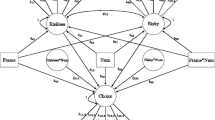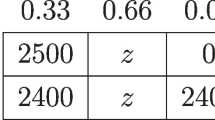Abstract
To be useful, cognitive models with fitted parameters should show generalizability across time and allow accurate predictions of future observations. It has been proposed that hierarchical procedures yield better estimates of model parameters than do nonhierarchical, independent approaches, because the formers’ estimates for individuals within a group can mutually inform each other. Here, we examine Bayesian hierarchical approaches to evaluating model generalizability in the context of two prominent models of risky choice—cumulative prospect theory (Tversky & Kahneman, 1992) and the transfer-of-attention-exchange model (Birnbaum & Chavez, 1997). Using empirical data of risky choices collected for each individual at two time points, we compared the use of hierarchical versus independent, nonhierarchical Bayesian estimation techniques to assess two aspects of model generalizability: parameter stability (across time) and predictive accuracy. The relative performance of hierarchical versus independent estimation varied across the different measures of generalizability. The hierarchical approach improved parameter stability (in terms of a lower absolute discrepancy of parameter values across time) and predictive accuracy (in terms of deviance; i.e., likelihood). With respect to test–retest correlations and posterior predictive accuracy, however, the hierarchical approach did not outperform the independent approach. Further analyses suggested that this was due to strong correlations between some parameters within both models. Such intercorrelations make it difficult to identify and interpret single parameters and can induce high degrees of shrinkage in hierarchical models. Similar findings may also occur in the context of other cognitive models of choice.








Similar content being viewed by others
Notes
The BUGS programming code for each model implementation is available in the online supplementary materials.
Because Nilsson et al. (2011) employed a different weighting function in their comparison of independent and hierarchical parameter estimations for CPT, our results are not directly comparable with theirs. Nevertheless, note that Nilsson et al. also found the hierarchical approach to yield a lower choice sensitivity. Interestingly, they obtained a pattern of results opposite to ours with regard to loss aversion, with the hierarchical approach yielding a higher λ.
See the online supplementary materials for the BUGS programming code.
See the online supplemental materials for similar plots of the other parameters.
Note, however, that this would not necessarily be the case. It is possible to conceive of situations in which shrinkage reduces the variance but retains the (linear) relationship between the individual parameters; in such cases, the test–retest correlations would not be lower for hierarchically estimated parameters, as they indeed are not for most of the parameters in Fig. 2.
For pragmatic reasons, in the hierarchical case all participants, including those predicted at t2 at any one time, were included in the parameter estimation. This may have yielded a small advantage for the hierarchical approach over the independent approach.
Bayes factor estimates were calculated from conventional t-test outputs on the basis of the template by Rouder, Speckman, Sun, Morey, and Iverson (2009), assuming the Jeffrey–Zellner–Siow prior and r = 1.
The range of the prior distribution has very little impact on the results when taking all 138 choices into account. Presumably, with this amount of data on the individual level, the influence of the prior on the posterior estimates is negligible.
If p is a vector of probabilities for making a correct prediction, the deviance is defined as –2*sum[log(p)], whereas the squared error is defined as sum[(1 – p)2].
References
Atkinson, G., & Nevill, A. M. (1998). Statistical methods for assessing measurement error (reliability) in variables relevant to sports medicine. Sports Medicine, 26, 217–238.
Berkowitsch, N. A. J., Scheibehenne, B., & Rieskamp, J. (2014). Testing multialternative decision field theory rigorously against random utility models. Journal of Experimental Psychology: General, 143, 1331–1348. doi:10.1037/a0035159
Birnbaum, M. H. (2008). New paradoxes of risky decision making. Psychological Review, 115, 463–501. doi:10.1037/0033-295X.115.2.463
Birnbaum, M. H., & Chavez, A. (1997). Tests of theories of decision making: Violations of branch independence and distribution independence. Organizational Behavior and Human Decision Processes, 71, 161–194.
Bland, J. M., & Altman, D. G. (1986). Statistical methods for assessing agreement between two methods of clinical measurement. Lancet, 327, 307–310.
Brown, G. D. A., Neath, I., & Chater, N. (2007). A temporal ratio model of memory. Psychological Review, 114, 539–576. doi:10.1037/0033-295X.114.3.539
Busemeyer, J. R., & Diederich, A. (2010). Cognitive modeling. New York, NY: Sage.
Dutilh, G., Forstmann, B. U., Vandekerckhove, J., & Wagenmakers, E.-J. (2013). A diffusion model account of age differences in posterror slowing. Psychology and Aging, 28, 64–76. doi:10.1037/a0029875
Edwards, W., Lindman, H., & Savage, L. J. (1963). Bayesian statistical inference for psychological research. Psychological Review, 70, 193–242.
Efron, B., & Morris, C. N. (1977). Stein’s paradox in statistics. Scientific American, 236, 119–127.
Fehr-Duda, H., De Gennaro, M., & Schubert, R. (2006). Gender, financial risk, and probability weights. Theory and Decision, 60, 283–313.
Fox, C. R., & Poldrack, R. A. (2008). Prospect theory and the brain. In P. W. Glimcher, E. Fehr, C. Camerer, & R. A. Poldrack (Eds.), Neuroeconomics: Decision making and the brain (pp. 145–174). San Diego, CA: Academic Press.
Gelman, A., Carlin, J. B., Stern, H. S., & Rubin, D. B. (2004). Bayesian data analysis (2nd ed.). Boca Raton, FL: Chapman & Hall/CRC.
Gelman, A., & Hill, J. (2007). Data analysis using regression and multilevel/hierarchical models. Cambridge, UK: Cambridge University Press.
Glöckner, A., & Pachur, T. (2012). Cognitive models of risky choice: Parameter stability and predictive accuracy of prospect theory. Cognition, 123, 21–32. doi:10.1016/j.cognition.2011.12.002
Goldstein, W. M., & Einhorn, H. J. (1987). Expression theory and the preference reversal phenomena. Psychological Review, 94, 236–254. doi:10.1037/0033-295X.94.2.236
Gonzalez, R., & Wu, G. (1999). On the shape of the probability weighting function. Cognitive Psychology, 38, 129–166.
Harbaugh, W. T., Krause, K., & Vesterlund, L. (2002). Risk attitudes of children and adults: Choices over small and large probability gains and losses. Experimental Economics, 5, 53–84.
Hendricks, W. A., & Robey, K. W. (1936). The sampling distribution of the coefficient of variation. The Annals of Mathematical Statistics, 7, 129–132.
Hopkins, W. G. (2000). Measures of reliability in sports medicine and science. Sports Medicine, 30, 1–15.
Kahneman, D., & Tversky, A. (1979). Prospect theory: An analysis of decision under risk. Econometrica, 47, 263–291.
Kruschke, J. K. (2011). Bayesian assessment of null values via parameter estimation and model comparison. Perspectives on Psychological Science, 6, 299–312. doi:10.1177/1745691611406925
Lee, M. D., & Newell, B. R. (2011). Using hierarchical Bayesian methods to examine the tools of decision-making. Judgment and Decision Making, 6, 832–842.
Lee, M. D., & Wagenmakers, E.-J. (2014). Bayesian cognitive modeling: A practical course. Cambridge, UK: Cambridge University Press.
Lee, M. D., & Webb, M. R. (2005). Modeling individual differences in cognition. Psychonomic Bulletin & Review, 12, 605–621. doi:10.3758/BF03196751
Lewandowsky, S. (2011). Working memory capacity and categorization: Individual differences and modeling. Journal of Experimental Psychology: Learning, Memory, and Cognition, 37, 720–738. doi:10.1037/a0022639
Lewandowsky, S., & Farrell, S. (2010). Computational modeling in cognition: Principles and practice. Thousand Oaks, CA: Sage.
Li, S.-C., Lewandowsky, S., & DeBrunner, V. E. (1996). Using parameter sensitivity and interdependence to predict model scope and falsifiability. Journal of Experimental Psychology: General, 125, 360–369. doi:10.1037/0096-3445.125.4.360
Lunn, D., Spiegelhalter, D., Thomas, A., & Best, N. (2009). The BUGS project: Evolution, critique and future directions. Statistics in Medicine, 28, 3049–3067.
Nilsson, H., Rieskamp, J., & Wagenmakers, E.-J. (2011). Hierarchical Bayesian parameter estimation for cumulative prospect theory. Journal of Mathematical Psychology, 55, 84–93. doi:10.1016/j.jmp.2010.08.006
Nosofsky, R. M. (1986). Attention, similarity, and the identification–categorization relationship. Journal of Experimental Psychology: General, 115, 39–57. doi:10.1037/0096-3445.115.1.39
Nosofsky, R. M., & Zaki, S. R. (2002). Exemplar and prototype models revisited: Response strategies, selective attention, and stimulus generalization. Journal of Experimental Psychology: Learning, Memory, and Cognition, 28, 924–940. doi:10.1037/0278-7393.28.5.924
Pachur, T., Hanoch, Y., & Gummerum, M. (2010). Prospects behind bars: Analyzing decisions under risk in a prison population. Psychonomic Bulletin & Review, 17, 630–636. doi:10.3758/PBR.17.5.630
Pachur, T., Hertwig, R., Gigerenzer, G., & Brandstätter, E. (2013). Testing process predictions of models of risky choice: A quantitative model comparison approach. Frontiers in Psychology, 4, 646. doi:10.3389/fpsyg.2013.00646
Pachur, T., Hertwig, R., & Wolkewitz, R. (2014). The affect gap in risky choice: Affect-rich outcomes attenuate attention to probability information. Decision, 1, 64–78.
Pachur, T., & Olsson, H. (2012). Type of learning task impacts performance and strategy selection in decision making. Cognitive Psychology, 65, 207–240. doi:10.1016/j.cogpsych.2012.03.003
Plummer, M. (2003). JAGS: A program for analysis of Bayesian graphical models using Gibbs sampling. In Proceedings of the 3rd International Workshop on Distributed Statistical Computing, 1–10. Retrieved from www.r-project.org/conferences/DSC-2003/Proceedings/Plummer.pdf
Pratte, M. S., & Rouder, J. N. (2011). Hierarchical single- and dual-process models of recognition memory. Journal of Mathematical Psychology, 55, 36–46. doi:10.1016/j.jmp.2010.08.007
Qiu, J., & Steiger, E.-M. (2011). Understanding the two components of risk attitudes: An experimental analysis. Management Science, 57, 193–199.
R Development Core Team. (2012). R: A language and environment for statistical computing [Computer software]. Vienna, Austria: R Foundation for Statistical Computing. Retrieved from www.R-project.org
Rieskamp, J. (2008). The probabilistic nature of preferential choice. Journal of Experimental Psychology: Learning, Memory, and Cognition, 34, 1446–1465. doi:10.1037/a0013646
Rouder, J. N., & Lu, J. (2005). An introduction to Bayesian hierarchical models with an application in the theory of signal detection. Psychonomic Bulletin & Review, 12, 573–604. doi:10.3758/BF03196750
Rouder, J. N., Lu, J., Morey, R. D., Sun, D., & Speckman, P. L. (2008). A hierarchical process-dissociation model. Journal of Experimental Psychology: General, 137, 370–389. doi:10.1037/0096-3445.137.2.370
Rouder, J. N., Speckman, P. L., Sun, D., Morey, R. D., & Iverson, G. (2009). Bayesian t tests for accepting and rejecting the null hypothesis. Psychonomic Bulletin & Review, 16, 225–237. doi:10.3758/PBR.16.2.225
Scheibehenne, B., Rieskamp, J., & Wagenmakers, E.-J. (2013). Testing adaptive toolbox models: A Bayesian hierarchical approach. Psychological Review, 120, 39–64. doi:10.1037/a0030777
Scheibehenne, B., & Studer, B. (2014). A hierarchical Bayesian model of the influence of run length on sequential predictions. Psychonomic Bulletin & Review, 20, 211–217. doi:10.3758/s13423-013-0469-1
Schmiedek, F., Oberauer, K., Wilhelm, O., Süß, H.-M., & Wittmann, W. W. (2007). Individual differences in components of reaction time distributions and their relations to working memory and intelligence. Journal of Experimental Psychology: General, 136, 414–429. doi:10.1037/0096-3445.136.3.414
Selten, R. (1998). Axiomatic characterization of the quadratic scoring rule. Experimental Economics, 1, 43–62.
Shiffrin, R. M., Lee, M. D., Kim, W., & Wagenmakers, E.-J. (2008). A survey of model evaluation approaches with a tutorial on hierarchical Bayesian methods. Cognitive Science, 32, 1248–1284.
Stewart, N. (2011). Information integration in risky choice: Identification and stability. Frontiers in Psychology, 2, 301. doi:10.3389/fpsyg.2011.00301
Stott, H. P. (2006). Cumulative prospect theory’s functional menagerie. Journal of Risk and Uncertainty, 32, 101–130.
Su, Y., Rao, L.-L., Sun, H.-Y., Du, X.-L., Li, X., & Li, S. (2013). Is making a risky choice based on a weighting and adding process? An eye-tracking investigation. Journal of Experimental Psychology: Learning, Memory, and Cognition, 39, 1765–1780. doi:10.1037/a0032861
Sutton, R., & Barto, A. (1998). Reinforcement learning: An introduction. Cambridge, MA: MIT Press.
Tversky, A., & Kahneman, D. (1992). Advances in prospect theory: Cumulative representation of uncertainty. Journal of Risk and Uncertainty, 5, 297–323.
van Ravenzwaaij, D., Dutilh, G., & Wagenmakers, E.-J. (2011). Cognitive model decomposition of the BART: Assessment and application. Journal of Mathematical Psychology, 55, 94–105. doi:10.1016/j.jmp.2010.08.010
Wetzels, R., Vandekerckhove, J., Tuerlinckx, F., & Wagenmakers, E.-J. (2010). Bayesian parameter estimation in the Expectancy Valence model of the Iowa gambling task. Journal of Mathematical Psychology, 54, 14–27. doi:10.1016/j.jmp.2008.12.001
Yechiam, E., & Busemeyer, J. R. (2008). Evaluating generalizability and parameter consistency in learning models. Games and Economic Behavior, 63, 370–394.
Yechiam, E., & Ert, E. (2011). Risk attitude in decision making: In search of trait‐like constructs. Topics in Cognitive Science, 3, 166–186.
Author information
Authors and Affiliations
Corresponding author
Electronic supplementary material
Below is the link to the electronic supplementary material.
ESM 1
(DOCX 230 kb)
Rights and permissions
About this article
Cite this article
Scheibehenne, B., Pachur, T. Using Bayesian hierarchical parameter estimation to assess the generalizability of cognitive models of choice. Psychon Bull Rev 22, 391–407 (2015). https://doi.org/10.3758/s13423-014-0684-4
Published:
Issue Date:
DOI: https://doi.org/10.3758/s13423-014-0684-4




